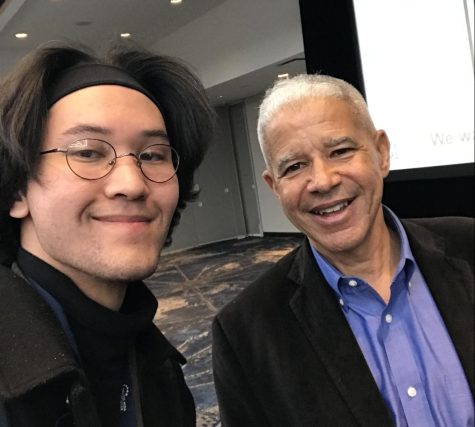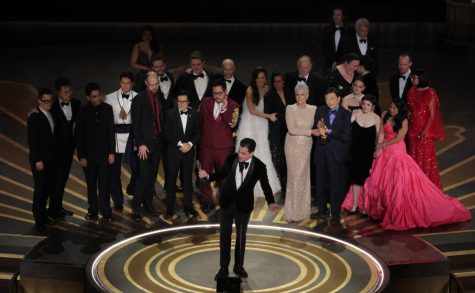Moulin Rouge: Where Your Dreams Come True
March 15, 2023
Synth and sensual music hypnotizes the audience as the characters of “Moulin Rouge” come from behind the curtain, building an ominous aura as the performers offer love for cheap. Decorated to the nines with a fake elephant as the main attraction, the hypnotizing, yet simulated intimacy ubiquitous in sex work is on full display on the sidelines in human-size bird cages. From the get-go, audiences are taken aback by the larger-than-life aura and on-stage theatrics luring us inside. Slowly closing the barrier between reality and show, Harold Zidler, played by Eric Anderson, takes the audience back in time to 1899 in Paris, and invites us to the Moulin Rouge.
“Voulez-vous coucher avec moi ce soir?” (“Do you want to sleep with me tonight?”)
Known for weaving together originals and modern chart-toppers, “Moulin Rouge” begins with “Lady Marmalade” by Labelle as, four burlesque dancers take the stage, tantalizing audiences with sensual song and dance. From emotional renditions of “Firework” by Katy Perry to “Can’t Help Falling in Love” by Elvis Presley, the Broadway show features a wide variety of musical inspirations palatable to modern audiences, compared to its senior 2001 soundtrack.
Following the opening dance number, the musical introduces “The Bohemians,” an adventurous trio of Christian, Santiago, and Toulouse-Lautrec — played by Aaron Tevit, Caleb Marshall-Villarreal, and André Ward respectively. Despite hailing from different backgrounds, the struggling artists are united under the mantra of “truth, beauty, freedom, and love”. All diamonds in the rough, they find themselves in Paris under the same morals and reasons, the three hopelessly devoted to a fleeting feeling and a future of freedom.
Coming down from the ceiling glistening in diamonds and jewels, the unique and indomitable Satine, played by Oyoyo Joi, introduces her highly anticipated self to the mashup of “Single Ladies” by Beyoncé, “Material Girl” by Madonna, as well as “Diamonds Are Forever” by Shirley Bassey, among others. Possessing a mysterious aura, “The Sparkling Diamond” usurps the attention of audiences and cast alike with her extravagance and confident demeanor.
Beneath her glossy exterior however, Satine suffers from tuberculosis and is aging past her prime. As the main attraction of the Moulin Rouge, the enchantress’ struggle to keep up appearances places the cabaret in jeopardy.
Despite the encompassing theme of lust, “Your Song” serves as an innocent moment of enduring love between Satine and Christian, offering a pleasant lull into genuine romance so strong that not even absinthe can shake. As both lovers fall deeper in love, Satine finds herself entangled in a loveless relationship with The Duke, played by David Harris, as per Zidler’s last ditch effort to fund the Moulin Rouge; a home to many, who without it would be on the streets or under them. While complicit in Zidler’s scheme, Satine continues to have affairs with Christian after hours, succumbing to passion despite knowing that their relationship is unfeasible.
“I hope you don’t mind/ That I put down in words/ How wonderful life is, while you’re in the world,” the two sing to each other.
The themes of tainted, addictive, and epic love are romanticized throughout. While the audience is made aware of the destructive and fleeting nature of infatuation, the characters portray romance as something only those who are truly enamored with each other can experience. Contrasting the pure love between Satine and Christian, Santiago and Nini — played by Jessia Lee Goldyn — indulge in romantic obsession to the tune of “Toxic” by Britney Spears and “Bad Romance” by Lady Gaga: songs befitting of two toxic lovers. A striking dance number and a breathtaking performance grips the stage, as we are allured back into the Moulin Rouge, once again.
In attempt to save themselves from financial ruin, the cabaret produces a play directed by André, an is funded by The Duke. Ironically, despite devoting their lives to the stage, Satine and Christian are unable to mask their emotions and openly indulge in their forbidden romance, to the chagrin of The Duke.
Forced to choose between the cabaret and her love, Christian pleads with Satine to stay with him: “You don’t have to put on the red light, Roxanne. I’m holding on for dear life… why does my heart cry?”
Despite her feelings for Christian, Satine places her found family above herself and puts on the red light, signaling that the show must go on.
Come what may, Satine is unable to push through and spends her last moment on the stage. No longer restrained by secrecy, the dancer embraces Christian, with the pair affirming their love to one another as she takes her final bow.
“Storm clouds may gather, stars may collide, but I’ll love you until the end of time.” Christian sings.
While the Moulin Rouge closes down, Satine’s legend lives on through Christian’s plays, who has achieved his mission to find love.
A constellation of themes about aging, eternal love, and sacrifice, the “Moulin Rouge” is an emotional tale that is far from easy to digest, much less to describe. Even though I had my notepad in hand, I found my words written on top of another as I didn’t want take my eyes of the stage, worried I might miss a second of theatre.
When you’re born into a life where you’ve only known one thing, it’s hard to accept that there is something more out in the world, especially for yourself. Trying your best to live for the people you care about is difficult when harsh expectations and unattainable standards are put upon you. So, being able to let loose and finally letting yourself come undone should be a relieving feeling that you would throw yourself into. But what about the whispers of others? The duties you have to perform? The life you’ve led for so long? You can’t just throw it all away… not without a price.
Leading an extravagant life can only be fulfilling for so long, until you want to break away and become reborn with someone new. Constantly craving for something different as the same theatrics ensue night after night, but knowing it’s unattainable is a feeling close to defeat. Putting yourself first is not something easy, even when all signs point towards it.
What I read in between the lines is that when something is right, it’ll find a way into your life; even if its in an unusual way. Even if something is to break you and leaves you at an ultimatum, showing selflessness for the people you love – a found family who came together with familiarities in differences – is something that is everlasting and transcends time and circumstance.
There was a clear artistic vision that went beyond aesthetics, but what art was meant to do; embed in your mind, and leave you trying to find something like it. The careful selection and slight playfulness of songs that were all combined into a mere few hours came together into an iconic masterpiece, that I can only imagine will be reinterpreted and reconstructed as the spirit of theatre lives on.
The ushers, however, were the most theatrical part of the play by demanding for phones to be put away as soon as the pre-show started with unmatched assertiveness. I found myself startled by their sneakiness and booming voices, but at the same time was amused that they had to repeat themselves until the show began.

















